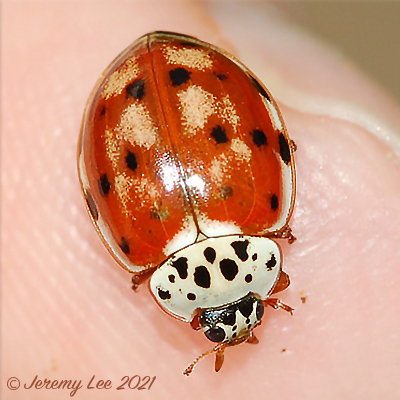
 |
|
Scientific Classifications explained » Amphibians » Ants » Aphids » Bees » Beetles » Birds » Bugs » Butterflies » Caterpillars » Damselflies » Dragonflies » Earwigs » Flies » Frog/Leafhoppers » Fungi » Galls » Grasshoppers » Harvestmen » Hoverflies » Lacewings » Ladybirds » Leaf Mines » Lichens » Mammals » Millipedes » Mosses » Moths » Sawflies » Slugs » Snails » Spiders » Trees & Shrubs » Wasps » Wild Flowers » Woodlice » Postboxes |
UK Nature > Ladybirds > Harmonia quadripunctata

Scientific Name: Harmonia quadripunctata Common Name: Cream-streaked Ladybird Harmonia quadripunctata, more commonly known as the cream-streaked ladybird, can reach a length of 5.5–6mm. The colouration is very variable; usually they are coloured bright red or yellow and have eight black dots on the elytra, with basal and lateral pale stripes. Some individuals with greatly expanded dark patches appear almost completely black. On the pronotum they usually have 11 black spots on a light background, with four or five larger black spots in the middle. This species is quite similar to H. axyridis, but in H. quadripunctata the small distinct humps before elytral apex and the M-like black painting on the pronotum, common in the reddish coloured specimen, are absent. It is a predator of various species of aphids such as Lachnus pinicola. The period of activity extends from March to October. These beetles over-winter in communities under the bark of various deciduous and coniferous trees such as pines and poplars. |
|

https://www.uknature.co.uk is a website dedicated to showing the immense diversity of UK nature and wildlife. Our vast range of habitats, from lowland arable to snow covered mountains, from storm-ravaged coastlines to peaceful inland freshwater lakes and rivers, from dry, sandy heaths to deciduous and coniferous forests, all these habitats contribute to the abundance of UK nature. We have wild birds in huge numbers either residing or visiting our shores (597 recorded species as at July 2013) and we must also not forget the humble back garden with its grass lawns, flower beds filled with nectar rich flowers, shrubs and trees, all designed to attract huge numbers of insects such as bees, moths, butterflies and hoverflies; and finally the small ponds which provide safe havens for frogs, toads, newts and even slow worms and grass snakes. www.uknature.co.uk is the showcase for my personal passion, photographing uknature in all its glory. I sincerely hope you all enjoy the fruits of my labours. This site and all images contained therein is © Jeremy Lee 2004 - 2025. All Rights Reserved. Site design by Jeremy Lee. Site development & IT Support by Stuart Lee. |